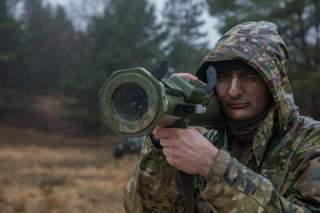U.S. Military Practices for A Second D-Day Landing (And Its Aimed at Russia)
Moscow should be worried.
U.S. Marines engaged in a mock beach landing in the Baltics on Tuesday in a scene reminiscent of the D-Day landings of World War II.

The drill took place as part of NATO’s Exercise Baltic Operations (BALTOPS), an annual exercise involving approximately 6,000 troops that runs from June 1 to 16. The drill, which took place on a beach in Latvia, is a key component of the exercise which aims to project NATO power from sea at a time when the Russian threat to the Baltics has taken a drastic increase.
“What we want to do is practice and demonstrate the ability to deliver sea control and power projection at and from the sea,” said U.S. Navy Adm. Christopher Grady, Joint Force Maritime Component Commander Europe.
Reserve Marines from Texas deployed from the the USS Arlington, an amphibious landing transport, onto the beach with various landing craft. The drill was conducted on the 73rd anniversary of the D-Day landings during World War II, the largest amphibious invasion in modern history.
The Latvian landing was significantly smaller in scope than the multiple landings on D-Day, but both operations involved a combination of air, maritime and land forces. BALTOPS, like D-Day, is also multinational, with 14 nations participating in various drills.
BALTOPS has been recurring since 1972, but this year’s event comes at a time when NATO’s tensions with Russia are at their highest since the end of the Cold War. The ongoing conflict in eastern Ukraine and Russia’s aggressive rhetoric has Balkan countries concerned they could be the next target.
“They’re scared to death of Russia,” said Gen. Raymond Thomas, head of U.S. Special Operations Command in January. “They are very open about that. They’re desperate for our leadership.”
The U.S. sent a detachment of special operations forces to the Baltics in January in order to help train local forces.
Russian forces could reach the capitals of both Latvia and neighboring Estonia in less than 60 hours, according to an assessment by the RAND corporation, even with a week’s notice. Latvia has approximately 4,450 active ground troops, while all three Baltic countries (Latvia, Lithuania and Estonia) have only around 15,750 between them. Estonia can also activate the 16,000 paramilitary troops in the Estonian Defense League, while Lithuania has around 10,000 militia members in the Lithuanian Rifleman’s Union.
NATO also has rotating forces throughout the Baltic region, but RAND’s assessment noted that they may not be enough to stave off a Russian attack.
“Such a rapid defeat would leave NATO with a limited number of options, all bad,” noted the report.
Fortunately for the Baltics, President Donald Trump has noted he is “absolutely committed” to the collective defense of NATO, a stark change from his previously doubtful outlook on alliance.
Content created by The Daily Caller News Foundation is available without charge to any eligible news publisher that can provide a large audience. For licensing opportunities of our original content, please contact [email protected].

